In previous articles, I’ve discussed situations where companies have successfully bolted American V8 engines into classic British sports cars, with the Sunbeam Tiger standing as a shining example. Those cars were produced utilizing considerable engineering knowledge, but what if an owner performed such a conversion in a home workshop? That is the question confronting the next owner of this 1976 Triumph Spitfire, and I have to say a big thank you to Barn Finder Chuck F for spotting it for us. Located in McDonough, Georgia, you will find the Triumph listed for sale here on Facebook. You could park it in your workshop for $5,500.
The Spitfire is finished in White, with a Black hardtop providing a striking contrast. Taken at face value, this Triumph shows promise. The paint appears acceptable for a driver-grade car, while there is no evidence of significant rust. The hardtop is missing the back window but is in otherwise good condition. Some of the trim could handle a refresh, and the new owner may elect to add rear fender flares if they intend to retain the enormous rear wheels and tires. The seller supplies no information on the state of the floors and frame, but we’re about to cover that subject in greater detail.
This Triumph’s engine bay would originally have housed a 1,491cc four-cylinder engine that sent its 57hp to the rear wheels via a four-speed manual transmission. That doesn’t sound like a recipe for excitement, and the ¼ mile ET supports that. The journey would take 19.2 seconds, with the Spitfire running out of breath before the needle nudged 100mph. However, this is now academic, thanks to the seller’s decision to consign the original motor to the bin and bolt in a Chevrolet small-block V8. Its capacity and specifications are unclear, but if it is a 350, the driver could have more than 300hp available under their right foot. The seller doesn’t indicate what transmission backs the V8, but I suspect it may be an automatic. The buyer will have a few tasks to tackle before the car moves under its own power. The main one will be fabricating a tailshaft, but plenty of engineering firms are capable of performing the work at a reasonable price. Before spending any money, it would be worth undertaking an in-person inspection. The best way would be to get the vehicle on a lift so that potential buyers can get a clear look at the frame. I can’t see evidence of any engineering or upgrades that would allow the frame to cope with the additional weight or torsional stresses the V8 will produce. That opens the possibility of the whole car twisting like a pretzel when the driver floors the loud pedal. The rear end and suspension mounts warrant a thorough check because the additional torque could rip mounting points out of the frame or turn the standard Triumph rear end into shrapnel. The seller installed a substantial rollcage to the interior, but it isn’t clear whether they tied this to the frame or simply bolted it to the floors. If they chose the latter route, it would add nothing to the car’s overall strength. Before this classic hits the road, the new owner may need to obtain engineering certification, satisfying authorities that it is safe. If the buyer can’t secure the necessary paperwork, there’s little chance that this classic could return to active service in any arena beyond a drag strip.
There’s not much to say about the Spitfire’s interior beyond the fact that the timber veneer dash looks restorable. There are seat bases but no backs and the door trims are a memory. The seller installed a substantial rollcage to improve safety, but the front bar restricts space in the footwell, potentially making the motoring experience uncomfortable. If the buyer intends to return the car to the streets, a retrim will be the order of the day. If a competition life is the aim, stripping away the carpet and unnecessary items would be the best path to follow.
In the legendary poem “If,” Rudyard Kipling wrote, “If you can meet with Triumph and Disaster, and treat those two impostors just the same.” That raises the question of how successful the marriage of this classic British sports car and an iconic American V8 is likely to be. Could it be a triumph, or is it more likely to be a disaster? Only an in-person inspection would determine how thorough the seller’s engineering has been and whether it represents a viable project build. There’s no doubt that if the buyer could return it to our roads, this Spitfire’s power-to-weight ratio would be phenomenal, promising performance that would border on the scary. Would it be a build you might consider tackling if it all checks out as viable?
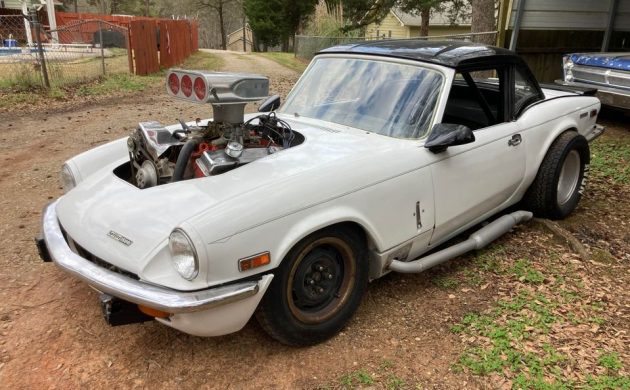
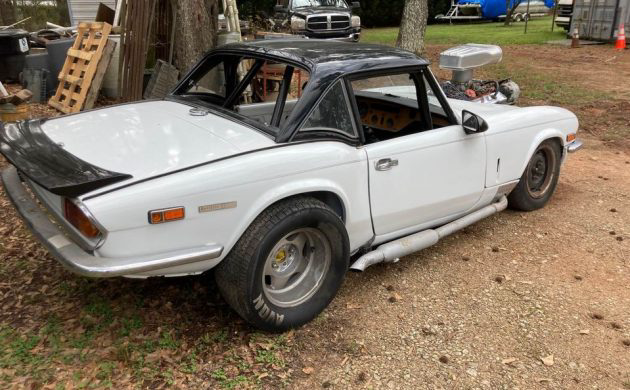
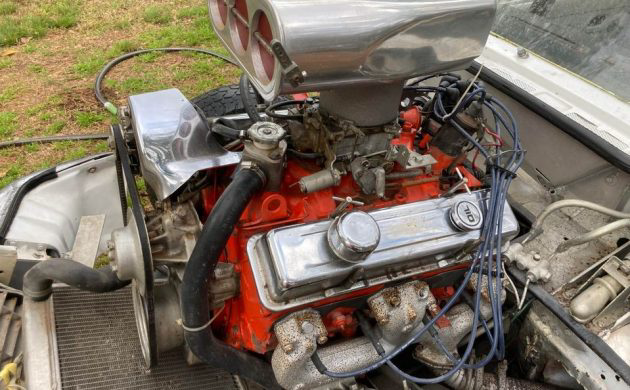
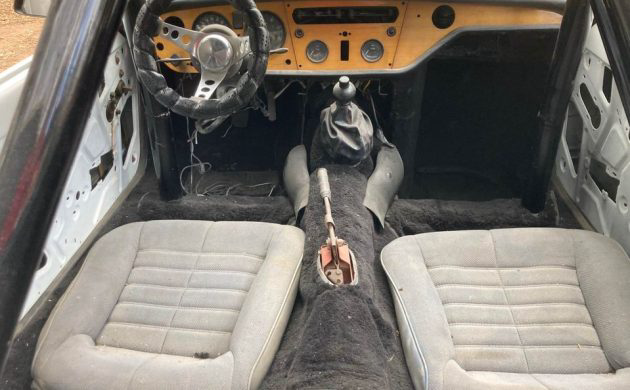
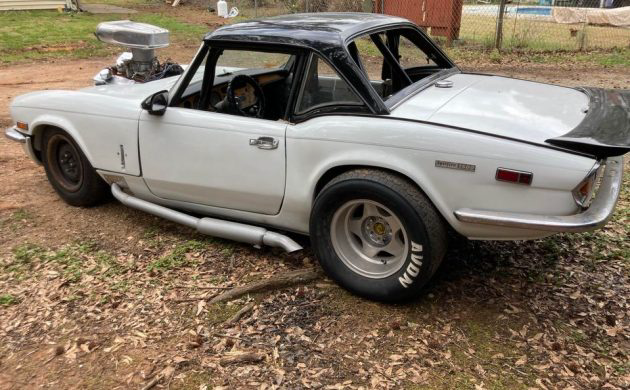


I would be inclined to name the car the Triumph Backfire. I’m a small dude so I would fit in this Triumph nicely I think I would struggle to be able to see around that imposter of a blower air horn. Besides all that if my friends saw me get out of this car they would accuse me of compensating for something besides a midlife crisis so I will have to take a hard pass on this one.
“Minor” things like totally compressed front springs and a stock Triumph rear end are good clues that the next phase of building this project would be a lengthly upgrade of the frame and suspension. Could be accomplished but the time and money numbers are going to be large.
Over 70 mph bet you can not even turn the front wheels, unsafe and a waste of a good engine.
What an astonishingly bad idea.
This is just automotive vandalism.
I hope the next buyer manages to get this to a driveable state. I don’t think it will ever be practical, or safe, or comfortable, or financially sound, or structurally sound, or good-looking, or enjoyable to drive. BUT, I think it would be a good laugh to see this thing scream down a quarter mile, so here’s hoping it makes it there someday.
I’d like to see film of the bonnet being opened…
The guys on the TV show, Hot Rod Garage did this with an MGB. Used a small block Ford, with suspension mods. It ran pretty well. So, this is possible, if you’re good with a wrench.
As they say in Ireland: “If I was going there, I wouldn´t start here”.
LMAO was my literal reaction instantly upon seeing the first photo.
At least Spitfires are body-on-frame, which makes it easier to… well, I was about to say reinforce the frame, but more likely you’d just fabricate an entire replacement chassis and suspension from scratch, to handle the power and weight difference adequately.
Well, it’s not the 1st time someone put an American monster engine( Packard/Merlin) in a Spitfire. Practically singlehandedly helped win the war, it did. THIS? Oh, come on, where’s you naysayers sense of fun? This was never meant to do anything except wow the onlookers. This belongs in Jamies collection, off on the side somewhere. Just for fun, folks. I’ve never seen a radiator mounted like that, and will surely overheat just as you pass the traps, if you make it that far, that is. Since I like British cars and American V8s, I should like this, and I do. I think it’s cool. I wonder what our British cousins think of this?
Merlin was entirely a Rolls-Royce engine, Howard. Packard had a license to produce it but it was not their design.
I´ve never been a big fan of the Triumph Spitfire and I do like custom cars. However, this is just terrible. A bad idea, very badly executed!
Mr. Horrocks: Please read this and see if you agree Packard and Ford both improved the Merlin so it could be mass produced.
https://www.autoweek.com/car-life/classic-cars/a30763715/rolls-royce-vs-packard-who-built-a-better-merlin/
Where do modifications become a new design?
Gerard Frederick: Remember the early Austins and Thames built into gassers for the drag strip? This could be the same with maybe more than a little “…engineering talent or money…”.
At least one of your British cousins think it’s not bad Howard, as long as it’s kept in a straight line it should be o.k. As for using it as a road car, I don’t think so as the forward vision is nearly non existent and if it performs as it should the front wheels are likely to lift off the ground making forward vision even worse. Personally I would lose the roll bar and the Chev motor and install the Buick/Rover V8 with a slush box. (You can tell I’m getting too old for street rods.) Ken Tilly. UK.
To Howard A.: it was more a case of an English Rolls-Royce motor being put in an America P-51 air frame. Martin is correct, in that the “Packard Merlin” was made under licence from Rolls-Royce.
At one point during the war, ALL the Packard Merlins were suffering from ball bearings crumbling–destroying the engines destined for the P-51s, while the Merlins being built in England for Mosquitoes, Lancasters and Spitfires, were fine. Rolls-Royce quickly sent a team to investigate why . It turned out that Packard was not following Rolls-Royce manufacturing procedures in one important regatd: instead of having the ball-bearings roll down a tube at a mild angle, gently, Packard had decided to have them fall vertically several feet, into boxes…
A judicious poke of the accelerator would likely twist this thing into a pretzel.
Ruined.
Speedway straight axle in front, multiple choice for A end, people would love it
Forrest’s Mamma always said that stupid is as stupid does.
Suicidal tendencies.
Sooooo many beers were held making this.
seriously?
For some reason, the thought of Ed “Big Daddy” Roth’s artwork (more so than his actual creations) comes to mind! ;)
I almost bought one of these with a sbc back in 88. It was built by a honest to God nuclear physicist and as you would expect it was beautifully done. Unfortunately for me he was so far in debt he couldn’t come up with the rest of the money for a down payment on the new vette he wanted and decided to keep it. Oh well, I would have probably killed myself it it anyway.
My mean streak would want this simply to cruise through some of the quiet more wealthy neighborhoods at 5am on a Saturday. I live in a smaller town but we do have a lot of people who like to cruise around in their Ferrari’s and Lamborghini cars when the weather turns nice
If you moved the radiator to the trunk instead of under the motor and dropped it down it wouldn’t look so horrid
What a truly horrible abortion. No amount of engineering talent or money could ever improve this mechanical circus freak.
Looks like the product of an innocent car and really bad drugs!
All you need now is a full sized model of Rat Fink next to it to finish off the statement. I love it as creative art! TOOOO MUCH!
If we live after the roll over let go shoot some squirrels
He used the Spitfire rear end? These cars had a IRS set-up that could barely handle the stock 57HP motor. I had a stock 1965 Spitfire: the 4 bolts attaching each of the two swing axels tended to shear off quite easily. My guess is that he utilized a regular differental (perhaps a ford 9″ or anything Positraction !)
I think a better choice would have been the 215 Buick V8. With the high compression heads and a 4 bbl it was good for about 220HP combined with the 200lbs of less nose weight would make this a spirited auto crosser
What a joke, that is how the radiator sits?
The Buick/Rover engine is about 50 lbs/ 20 kgs lighter than the 4 cylinder when MG did it too , much better idea 👍
I love Triumphs ,but this looks like crap
It’s an abomination. They’d censor me at BAT for saying that (they did a couple of years ago). Long live BF, where you can say it straight!
Well, that’s just dumb.
As far as Spit frame strength, its actually pretty stout. Its already boxed, and its a back-bone style chassis and not a ladder so less flex. That said, this is for making a lot of noise on a 20-30mph cruise night. It could be drags but I’m willing to bet the overall setup would never pass safety tech.
Anyone can restore a car, but it takes a real man to chop one up. Can any of you wheenies say HOT ROD.
It looks like the rear wheels are held on with two lug nuts each. Must be titanium or some space age alloy.
Good eye, weight reduction.
Hark the Herald axles swing. Ralph Nader was spot on with the Corvair and ever other swing axle car.
A coffin on wheels…full stop…not that I”m sure this contraption would be able to stop (pun intended!)
Because some BIG American cars of the ’50s and ’60s were available with different engine options, such as a six, a small V-8 and a high-power V-8…with only minor differences in the braking and suspension…while the chassis could handle all the engine options…it became ingrained in the American hot-rodding automotive psyche, that if you want monster power galore, all you need to do is just “drop” in a way more powerful engine. When dealing with small sports cars, even a modest increase in power and torque require much study and testing, to avert disastrous/dangerous consequences when driving fast, say down a twisting mountain pass!
When the late Ken Miles just “dropped” a 260 Ford V-8 into a Sunbeam Alpine in 1963 and took it for a spirited highway drive, it didn’t take long for lots of things to twist and break, including the wheels! He was lucky to have survived that earlier brush with death! It took lots of engineering and testing for Shelby American to eventually modify an Alpine for it to be safe enough for Lord Rootes to test drive. The Tiger was no quick backyard swap!
I think another reason why so many people have thought that a small sports car can easily handle a lot more power with little in the way of modifications, is that the AC Ace was able to take the street 260 and 289 V-8s with only relatively minor mods. The AC, though, was no ordinary little mass-produced sports car, as some think. Its Tojeiro chassis was the product of well-researched racing engineering, with twin strong three inch stee ltubes, independent rear suspension working with transverse leaf springs. That Tojeiro chassis was also the first one ever designed specifically for the characteristics of radial tyres (I know…”tires” in America). Therefore, AC Cars of Thames-Ditton, Surrey, south of London, only needed to add another leaf to the Ace’s springs, strengthen the exiisting chassis a bit to handle the extra torque…and so on. Racing Cobras with well over 300 horsepower, and later 427 and 428 Cobras, were a different story, in that they required lots more changes. However, a Spitfire with a backyard 350 conversion? Whoever decides to take it for its maiden drive had better make sure that the old life insurance payments are up to date. ..
Anything is possible, or maybe even probable with lotsa time, tools, engineering savy and enough green, this orphan and toy could just be an old school type build/built from the ground up screamer.
Now whether ot not there’s somebody who is that venturesome, ah got no idea.
Given the SIZE of a Spitfire, Tony Geloso, the only thing that could actually work is a monster truck version of a Spitfire. You would need bigger wheels and a bigger/longer/wider chassis…with the little Spitfire just sitting above it all…looking like a human-sized hat sitting atop a whale. One can’t change the laws of physics.
Is there a BF record for the number of replies to a listing? This has to be in the running!
A lot of effort went into this. Shame he never got to drive it.
Although where he would have driven it…. I mean, can you just build something like this and take it on the road? Are there people who would insure it?
A lot of negative comments but a lot of comments. Someone with the skills and shop equipment could for a small price make this a fun weekend or daily driver to work to freak all the early birds up on their way to work. I think a turbo 4 cylinder would be a better way to go but… WE ALL LIKE MATCHBOX CARS!!!. At least he tried.
Love the car